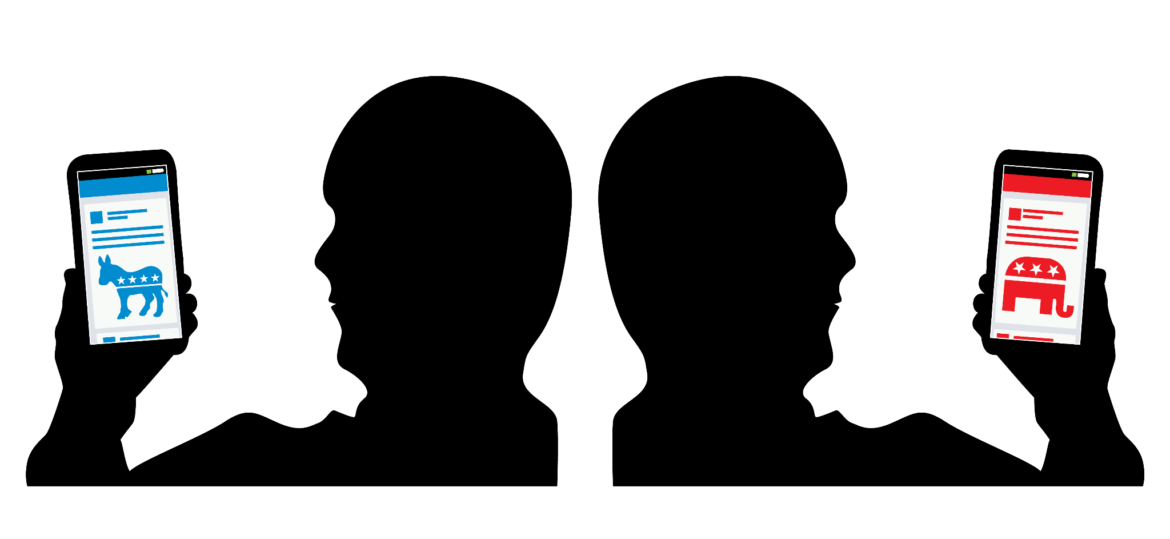Social media, in comparison to conventional media, can easily promote the establishment of substantial personal networks. Because a significant percentage of the population uses social media to create content, access information, and connect with others on a regular basis, online platforms are recognized influencers of users’ habits. It has been proven that the interchangeability of social feeds may have an impact on users’ online expressions and real-world behaviors and that these are susceptible to early social influence (1). This premature phenomenon often contributes to the creation of echo chambers, homogeneously systematized information environments regularly linked with fundamentalist ideologies and the spreading of fake news, which can ultimately result in polarisation when it comes to divisive subjects such as elections, vaccination, immigration or climate change (1).
As it was briefly mentioned above, the polarisation issue is heavily present in electoral campaigns and politics in general, making us wonder what is driving this phenomenon. Levi Boxell et al. concluded that there was a link between social media usage and increased polarisation, which made it clear that this was one of the major drivers of political polarisation (2). The number of Americans who consistently hold liberal or conservative ideas – rather than a mix of the two, as most people do – has risen from 10% to over 20% in the last two decades and there is growing evidence that this phenomenon is becoming global. At the same time, unfavourable perceptions of the opposing side are increasing (3). This deepening polarisation currently anticipates social policy preferences better than any other demographic variable which not only compromises the design and execution of social programs but also has the potential to result in government shutdowns, public riots, and violent attacks on elected officials thus endangering democracy’s overall effectiveness (3).
It is therefore important to understand how biased this ecosystem is, accounting for both the social media platform’s algorithmic bias and the overall impact of social interactions, mediated and regulated by the platform’s mechanisms and policies (1). For that purpose, a group of researchers recently decided to apply a methodology based on the deployment and monitoring of social bots with unbiased and random behaviour on Twitter. The only distinctive difference between these was the first account they followed. This account had to be a popular news source chosen to reflect sides across the political spectrum. Following deployment, it became obvious that, as previous research had indicated, early decisions regarding which sources to follow influenced social media users’ experiences (1). What was unknown was that these partisan-dependent disparities were ascribed to their interactions with users and content mediated through the social media platform, reflecting an overall bias of the entire information ecosystem. It’s also worth noting that the ecosystem exposed social bots that began their “search” by following a right-wing-leaning source to far more low-credibility information than others (1). This is in line with prior research where it was shown that conservative users were more inclined to engage with disinformation on social media.
From a slightly different angle, Duke University’s research group showed that polarisation in the US could be driven by exposure to opposing viewpoints (4). The researchers recruited hundreds of US Democrats and Republicans who were active on Twitter and paid them to follow a Twitter bot that retweeted information from those with opposing political ideologies (e.g. elected officials, opinion leaders, media organizations, and nonprofit groups). After one month, the Democrats kept roughly the same opinions whereas the Republicans further deepened their conservative mindset (4).
This is an issue that needs to be solved via a coordinated corporative and individual effort in order to reduce the likelihood of conflict and increase the possibility of collaboration. Not only do social media companies need to do more to fight online extremism and segregation, such as better regulating political ad targeting on their platforms, but also individuals must attempt to develop a more varied network that extends beyond their personal circles because even if they are not directly exposed to opposing perspectives, acquaintances can provide them with a level of political variety that may encourage more political moderation (3). Unfortunately, this variety won’t always lead to peace, because individuals are also more likely to come across a powerful emotive language that might elicit unfavourable political emotions. Therefore, the change needs to be more radical at the personal cognitive level. There is a well documented cognitive style, Actively Open-Minded Thinking (AOT), that encourages people to be more thoughtful, flexible, and open-minded, especially when new knowledge contradicts their previously held beliefs (5). A recent study has shown that conservatives and liberals who perform better on AOT, for example, are less likely to be polarized on hot-button subjects like climate change paving the way for the possibility of happening the same within politics (5).
It’s important to note that the majority of the studies mentioned in this article are Twitter-based and US-centric, which leads us to believe that similar questions could be investigated on a variety of other platforms and political contexts around the world, potentially generating distinct results. As we have seen, the answer to our dilemma may not be entirely beyond our grasp. Demanding talks become more constructive when we treat online places as if they were our own community. Everyone wins when we deliberately attempt to be more thoughtful and open-minded, regardless of how sure we are in our arguments or how offended we feel. With this in mind, and as a take-home message from this article, let’s rethink our approach towards how we interact and scrutinize political content on social media platforms by trying to build up and maintain a transversal unbiased mindset. Only after we reach this state, will we be able to actively fight polarisation and become major contributors to a healthy democracy.
Rafael Luis Pereira Santos
References
(1) Chen W., Pacheco D., Yang KC, et al. (2021) “Neutral bots probe political bias on social media”, Nat Commun 12.
(2) Boxell L., Gentzkow M., and Shapiro J. (2017) “Is the Internet Causing Political Polarization? Evidence from Demographics”, National Bureau of Economic Research.
(3) De-Wit L., Van der Linden S., and Brick C. (2019) “Are Social Media Driving Political Polarization?”, Greater Good Magazine.
(4) Bail A.C., Argyle L.P., Brown T.W., et al. (2018) “Exposure to opposing views on social media can increase political polarization”, Proceedings of the National Academy of Sciences.
(5) Stenhouse N., Myers T.A., Vraga E.K., et al. (2018) “The potential role of actively open-minded thinking in preventing motivated reasoning about controversial science”, Journal of Environmental Psychology.



